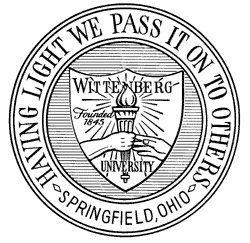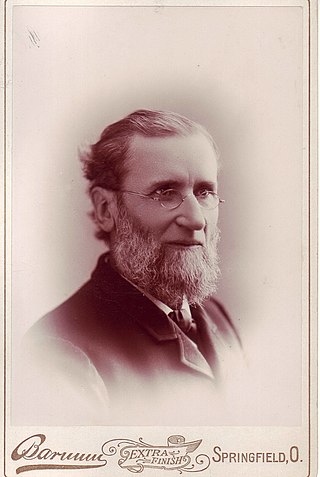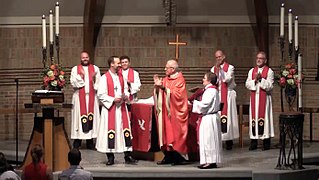
Wittenberg University is a private liberal arts college in Springfield, Ohio. It has 1,326 full-time students representing 33 states and 9 foreign countries. Wittenberg University is associated with the Evangelical Lutheran Church in America.

The Lutheran Church – Missouri Synod (LCMS), also known as the Missouri Synod, is a traditional, confessional Lutheran denomination in the United States. With 1.8 million members, it is the second-largest Lutheran body in the United States. The LCMS was organized in 1847 at a meeting in Chicago, Illinois, as the German Evangelical Lutheran Synod of Missouri, Ohio, and Other States, a name which partially reflected the geographic locations of the founding congregations.
The Evangelical Lutheran Church in America (ELCA) is a mainline Protestant Lutheran church headquartered in Chicago, Illinois. The ELCA was officially formed on January 1, 1988, by the merging of three Lutheran church bodies. As of 2021, it has approximately 3.04 million baptized members in 8,724 congregations.

The Wisconsin Evangelical Lutheran Synod (WELS), also referred to simply as the Wisconsin Synod, is an American Confessional Lutheran denomination of Christianity. Characterized as theologically conservative, it was founded in 1850 in Milwaukee, Wisconsin.

The American Lutheran Church (ALC) was a Christian Protestant denomination in the United States and Canada that existed from 1960 to 1987. Its headquarters were in Minneapolis, Minnesota. Upon its formation in 1960, The ALC designated Augsburg Publishing House, also located in Minneapolis, as the church publisher. The Lutheran Standard was the official magazine of The ALC.
The Lutheran Church in America (LCA) was an American and Canadian Lutheran church body that existed from 1962 to 1987. It was headquartered in New York City and its publishing house was Fortress Press.

The Evangelical Lutheran Synodical Conference of North America, often known simply as the Synodical Conference, was an association of Lutheran synods that professed a complete adherence to the Lutheran Confessions and doctrinal unity with each other. Founded in 1872, its membership fluctuated as various synods joined and left it. Due to doctrinal disagreements with the Lutheran Church–Missouri Synod (LCMS), the Evangelical Lutheran Synod (ELS) and the Wisconsin Evangelical Lutheran Synod (WELS) left the conference in 1963. It was dissolved in 1967 and the other remaining member, the Synod of Evangelical Lutheran Churches, merged into the LCMS in 1971.
The Evangelical and Reformed Church (E&R) was a Protestant Christian denomination in the United States. It was formed in 1934 by the merger of the Reformed Church in the United States (RCUS) with the Evangelical Synod of North America (ESNA). A minority within the RCUS remained out of the merger in order to continue the name Reformed Church in the United States. In 1957, the Evangelical and Reformed Church merged with the majority of the Congregational Christian Churches (CC) to form the United Church of Christ (UCC).
Trinity Lutheran Seminary at Capital University is an Evangelical Lutheran seminary in Columbus, Ohio.

Robert Sylvester Graetz Jr. was a Lutheran clergyman who, as the white pastor of a black congregation in Montgomery, Alabama, openly supported the Montgomery bus boycott, a landmark event of the civil rights movement.
The Evangelical Lutheran General Synod of the United States of America, commonly known as the General Synod, was a historical Lutheran denomination in the United States. Established in 1820, it was the first national Lutheran body to be formed in the U.S. and by 1918 had become the third largest Lutheran group in the nation. In 1918, the General Synod merged with other Lutheran denominations to create the United Lutheran Church in America. Both the General Synod and the United Lutheran Church are predecessor bodies to the contemporary Evangelical Lutheran Church in America.
The Japan Evangelical Lutheran Church or JELC is a Lutheran church in Japan. It currently has approximately 21,990 baptized members in 122 congregations nationwide.

Luther Alexander Gotwald, D.D. was a professor of theology in the Wittenberg Theological Seminary in the United States. He was tried for heresy by the board of directors at Wittenberg College in Springfield, Ohio, on April 4 and 5, 1893, which put on trial many key issues that Lutherans still debate today.

Gottlieb Bender Christiansen was an American Lutheran Minister who served as President at Trinity Seminary in Blair, Nebraska and was the first president of the United Danish Evangelical Lutheran Church.
Illinois State University was a private institution of higher learning in Springfield, Illinois. It began as The Literary and Theological Institute of the Lutheran Church in the Far West in Hillsboro, Illinois, in 1847. It soon became known as the Lutheran College, and, locally, as Hillsboro College. In 1852, it relocated to Springfield and changed its name to Illinois State University. It ceased operations in 1868, but reopened as Carthage College in Carthage, Illinois, in 1870.
The Evangelical Lutheran Joint Synod of Ohio and Other States, commonly known as the Joint Synod of Ohio or the Ohio Synod, was a German-language Lutheran denomination whose congregations were originally located primarily in the U.S. state of Ohio, later expanding to most parts of the United States. The synod was formed on September 14, 1818, and adopted the name Evangelical Lutheran Joint Synod of Ohio and Other States by about 1850. It used that name or slight variants until it merged with the Iowa Synod and the Buffalo Synod in 1930 to form the first American Lutheran Church (ALC), 1930–1960.

John F. Bradosky is an American Lutheran Bishop. He was the second Bishop of the North American Lutheran Church, from his election on 11 August 2011 until his successor, the Rev. Dr. Dan Selbo, was elected as Bishop on 9 August 2019. He followed Rev. Paull Spring, who served as the NALC Provisional Bishop from its inception, and was the former Bishop of the ELCA Northwestern Pennsylvania Synod.
The American Lutheran Church (ALC) was formed in 1930 from the merger of the three conservative Lutheran synods of German-American origin: The Evangelical Lutheran Synod of Iowa and Other States, established in 1854; the Lutheran Synod of Buffalo, established in 1845; and the Evangelical Lutheran Joint Synod of Ohio and Other States, established in 1818 from the Ministerium of Pennsylvania. The headquarters of the ALC were in Columbus, Ohio, which had been the headquarters of the Joint Synod of Ohio, the largest of the three synods.

Concordia College was a Lutheran college and high school in Conover, North Carolina. Founded as a high school by members of the Evangelical Lutheran Tennessee Synod in 1878, it added college courses in 1881. The English Evangelical Lutheran Synod of Missouri and Other States took over control of the school in 1893. Control passed to the Lutheran Church–Missouri Synod when the English Synod merged with it in 1911. In April 1935, a fire destroyed the main building, and the school closed permanently at the end of the spring semester.

Immanuel Lutheran College was an educational institution of the Evangelical Lutheran Synodical Conference of North America whose main purpose was to train Black men to be pastors and both men and women to be teachers. It was founded in Concord, North Carolina, in 1903 and relocated to Greensboro, North Carolina, in 1905. The college was closed in 1961 when the Synodical Conference decided that the training of Blacks should be integrated into the educational institutions of the Lutheran Church–Missouri Synod (LCMS), the largest member of the conference. The former campus was purchased by North Carolina A&T State University.











